Name Some Factors That Can Cause a Shift in the Supply Curve in Markets for Goods and Services.
Chapter 3. Demand and Supply
3.2 Shifts in Need and Supply for Goods and Services
Learning Objectives
Past the end of this section, you volition be able to:
- Place factors that affect demand
- Graph need curves and demand shifts
- Place factors that touch supply
- Graph supply curves and supply shifts
The previous module explored how cost affects the quantity demanded and the quantity supplied. The event was the demand curve and the supply bend. Price, however, is not the only affair that influences demand. Nor is it the only thing that influences supply. For example, how is demand for vegetarian food affected if, say, health concerns crusade more consumers to avoid eating meat? Or how is the supply of diamonds affected if diamond producers discover several new diamond mines? What are the major factors, in addition to the cost, that influence demand or supply?
Visit this website to read a cursory note on how marketing strategies can influence supply and demand of products.

What Factors Touch on Need?
Nosotros divers need as the amount of some product a consumer is willing and able to purchase at each price. That suggests at least ii factors in add-on to cost that touch demand. Willingness to buy suggests a desire, based on what economists call tastes and preferences. If you lot neither need nor want something, you will not purchase it. Ability to buy suggests that income is of import. Professors are normally able to afford meliorate housing and transportation than students, because they have more income. Prices of related appurtenances tin affect demand also. If you need a new motorcar, the cost of a Honda may touch your demand for a Ford. Finally, the size or composition of the population can touch on demand. The more children a family has, the greater their demand for habiliment. The more driving-age children a family has, the greater their need for auto insurance, and the less for diapers and infant formula.
These factors matter both for demand by an individual and demand past the market every bit a whole. Exactly how do these various factors affect demand, and how do we show the effects graphically? To answer those questions, we need the ceteris paribus assumption.
The Ceteris Paribus Supposition
A demand curve or a supply curve is a relationship between two, and merely two, variables: quantity on the horizontal centrality and toll on the vertical centrality. The assumption behind a need curve or a supply curve is that no relevant economic factors, other than the product's price, are irresolute. Economists call this supposition ceteris paribus, a Latin phrase pregnant "other things beingness equal." Any given demand or supply curve is based on the ceteris paribus assumption that all else is held equal. A need curve or a supply curve is a relationship betwixt ii, and merely two, variables when all other variables are kept constant. If all else is non held equal, then the laws of supply and need will not necessarily concord, as the post-obit Clear It Up feature shows.
When does ceteris paribus employ?
Ceteris paribus is typically applied when nosotros look at how changes in price affect demand or supply, but ceteris paribus can be applied more generally. In the real world, demand and supply depend on more than factors than only price. For example, a consumer'due south demand depends on income and a producer'southward supply depends on the toll of producing the product. How can we analyze the outcome on demand or supply if multiple factors are irresolute at the same time—say price rises and income falls? The answer is that nosotros examine the changes 1 at a time, assuming the other factors are held abiding.
For example, we can say that an increase in the price reduces the corporeality consumers will purchase (assuming income, and anything else that affects need, is unchanged). Additionally, a subtract in income reduces the amount consumers tin can beget to buy (assuming price, and anything else that affects demand, is unchanged). This is what the ceteris paribus assumption really means. In this particular instance, afterwards we analyze each factor separately, nosotros tin combine the results. The corporeality consumers buy falls for two reasons: kickoff because of the higher price and 2nd because of the lower income.
How Does Income Affect Demand?
Let's use income every bit an example of how factors other than cost affect demand. Figure 1 shows the initial demand for automobiles as D0. At indicate Q, for case, if the price is $xx,000 per machine, the quantity of cars demanded is 18 1000000. D0 likewise shows how the quantity of cars demanded would modify as a effect of a college or lower toll. For example, if the price of a car rose to $22,000, the quantity demanded would decrease to 17 million, at point R.
The original demand curve D0, like every demand bend, is based on the ceteris paribus assumption that no other economically relevant factors alter. Now imagine that the economy expands in a way that raises the incomes of many people, making cars more affordable. How volition this touch on demand? How can we show this graphically?
Return to Effigy 1. The cost of cars is still $twenty,000, but with college incomes, the quantity demanded has now increased to xx million cars, shown at betoken South. As a event of the college income levels, the demand curve shifts to the right to the new need bend D1, indicating an increment in need. Tabular array four shows clearly that this increased need would occur at every price, not just the original one.
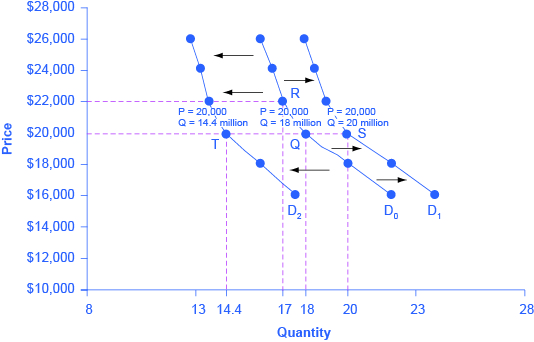
| Price | Subtract to D2 | Original Quantity Demanded D0 | Increase to Dane |
|---|---|---|---|
| $16,000 | 17.6 meg | 22.0 1000000 | 24.0 million |
| $18,000 | 16.0 million | xx.0 meg | 22.0 million |
| $20,000 | xiv.4 one thousand thousand | 18.0 million | 20.0 million |
| $22,000 | 13.6 meg | 17.0 one thousand thousand | 19.0 million |
| $24,000 | 13.2 million | 16.5 million | 18.5 1000000 |
| $26,000 | 12.eight one thousand thousand | 16.0 million | 18.0 million |
| Table 4. Toll and Demand Shifts: A Car Example | |||
Now, imagine that the economy slows downwards so that many people lose their jobs or piece of work fewer hours, reducing their incomes. In this case, the decrease in income would atomic number 82 to a lower quantity of cars demanded at every given cost, and the original demand curve D0 would shift left to D2. The shift from D0 to Dii represents such a decrease in need: At whatever given price level, the quantity demanded is now lower. In this instance, a price of $20,000 ways 18 million cars sold along the original demand curve, but only xiv.4 million sold later demand fell.
When a demand curve shifts, it does not mean that the quantity demanded past every individual buyer changes by the same amount. In this example, non everyone would have higher or lower income and not everyone would buy or not buy an additional automobile. Instead, a shift in a need curve captures an pattern for the market as a whole.
In the previous department, we argued that higher income causes greater demand at every price. This is true for most appurtenances and services. For some—luxury cars, vacations in Europe, and fine jewelry—the event of a rise in income can be especially pronounced. A product whose need rises when income rises, and vice versa, is chosen a normal good. A few exceptions to this design do exist. As incomes rise, many people will purchase fewer generic brand groceries and more name brand groceries. They are less likely to buy used cars and more than likely to buy new cars. They volition be less likely to rent an apartment and more likely to ain a home, and and then on. A product whose demand falls when income rises, and vice versa, is chosen an inferior practiced. In other words, when income increases, the demand bend shifts to the left.
Other Factors That Shift Demand Curves
Income is not the merely factor that causes a shift in need. Other things that change demand include tastes and preferences, the composition or size of the population, the prices of related goods, and even expectations. A change in any i of the underlying factors that determine what quantity people are willing to buy at a given price will cause a shift in demand. Graphically, the new demand curve lies either to the right (an increase) or to the left (a decrease) of the original demand bend. Permit'south await at these factors.
Changing Tastes or Preferences
From 1980 to 2014, the per-person consumption of chicken by Americans rose from 48 pounds per year to 85 pounds per year, and consumption of beef fell from 77 pounds per year to 54 pounds per twelvemonth, according to the U.S. Section of Agriculture (USDA). Changes like these are largely due to movements in taste, which change the quantity of a skilful demanded at every price: that is, they shift the demand curve for that proficient, rightward for chicken and leftward for beefiness.
Changes in the Composition of the Population
The proportion of elderly citizens in the Us population is rising. It rose from ix.8% in 1970 to 12.6% in 2000, and will be a projected (by the U.S. Census Bureau) 20% of the population past 2030. A lodge with relatively more children, similar the U.s. in the 1960s, will have greater need for appurtenances and services like tricycles and day care facilities. A society with relatively more than elderly persons, as the United States is projected to have by 2030, has a higher demand for nursing homes and hearing aids. Similarly, changes in the size of the population tin can bear upon the demand for housing and many other goods. Each of these changes in need will be shown as a shift in the demand curve.
The demand for a product can also be afflicted by changes in the prices of related appurtenances such as substitutes or complements. A substitute is a good or service that can exist used in place of another good or service. As electronic books, like this ane, get more bachelor, you would await to see a decrease in demand for traditional printed books. A lower toll for a substitute decreases need for the other production. For example, in recent years equally the price of tablet computers has fallen, the quantity demanded has increased (because of the police force of demand). Since people are purchasing tablets, there has been a decrease in need for laptops, which tin can be shown graphically as a leftward shift in the demand curve for laptops. A higher toll for a substitute skilful has the reverse outcome.
Other goods are complements for each other, meaning that the goods are often used together, because consumption of ane good tends to heighten consumption of the other. Examples include breakfast cereal and milk; notebooks and pens or pencils, golf game balls and golf clubs; gasoline and sport utility vehicles; and the v-style combination of bacon, lettuce, tomato, mayonnaise, and bread. If the price of golf clubs rises, since the quantity demanded of golf clubs falls (because of the police of demand), demand for a complement good like golf balls decreases, also. Similarly, a higher price for skis would shift the demand bend for a complement good like ski resort trips to the left, while a lower toll for a complement has the opposite effect.
Changes in Expectations about Future Prices or Other Factors that Affect Demand
While it is clear that the price of a good affects the quantity demanded, it is also true that expectations about the hereafter price (or expectations about tastes and preferences, income, and and then on) tin touch on demand. For case, if people hear that a hurricane is coming, they may rush to the store to buy flashlight batteries and bottled water. If people learn that the cost of a practiced like coffee is likely to rising in the future, they may head for the store to stock up on coffee now. These changes in demand are shown as shifts in the curve. Therefore, a shift in need happens when a change in some economic factor (other than cost) causes a different quantity to exist demanded at every price. The post-obit Work It Out characteristic shows how this happens.
Shift in Demand
A shift in demand means that at any cost (and at every price), the quantity demanded will be different than it was before. Following is an case of a shift in demand due to an income increase.
Pace one. Describe the graph of a need curve for a normal good like pizza. Option a price (like P0). Identify the corresponding Q0. An example is shown in Figure two.
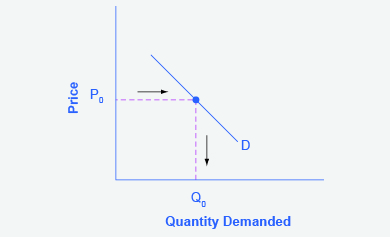
Stride 2. Suppose income increases. As a event of the change, are consumers going to purchase more or less pizza? The answer is more. Draw a dotted horizontal line from the chosen cost, through the original quantity demanded, to the new point with the new Q1. Draw a dotted vertical line downward to the horizontal axis and label the new Qane. An example is provided in Figure iii.
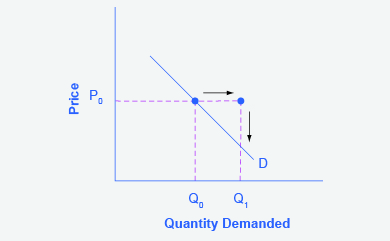
Step 3. Now, shift the curve through the new bespeak. You will see that an increment in income causes an upward (or rightward) shift in the need curve, so that at any price the quantities demanded will exist college, as shown in Figure 4.

Summing Upward Factors That Change Demand
Six factors that can shift demand curves are summarized in Figure 5. The direction of the arrows indicates whether the demand bend shifts represent an increase in demand or a decrease in demand. Detect that a modify in the price of the good or service itself is not listed among the factors that can shift a need curve. A alter in the price of a good or service causes a movement along a specific demand curve, and it typically leads to some alter in the quantity demanded, but it does not shift the demand curve.

When a demand curve shifts, it will then intersect with a given supply curve at a different equilibrium price and quantity. Nosotros are, however, getting ahead of our story. Before discussing how changes in need tin affect equilibrium price and quantity, we starting time need to discuss shifts in supply curves.
How Product Costs Affect Supply
A supply bend shows how quantity supplied volition change as the price rises and falls, bold ceteris paribus then that no other economically relevant factors are changing. If other factors relevant to supply do modify, then the entire supply curve volition shift. Just as a shift in demand is represented by a change in the quantity demanded at every toll, a shift in supply means a change in the quantity supplied at every price.
In thinking about the factors that bear on supply, remember what motivates firms: profits, which are the difference between revenues and costs. Goods and services are produced using combinations of labor, materials, and machinery, or what we call inputs or factors of production. If a business firm faces lower costs of production, while the prices for the skillful or service the firm produces remain unchanged, a firm'due south profits go up. When a firm'southward profits increase, information technology is more motivated to produce output, since the more it produces the more profit it will earn. And then, when costs of product fall, a house will tend to supply a larger quantity at any given price for its output. This can be shown by the supply curve shifting to the right.
Take, for case, a messenger company that delivers packages around a urban center. The company may notice that buying gasoline is one of its principal costs. If the price of gasoline falls, then the company will find information technology can deliver messages more cheaply than before. Since lower costs correspond to higher profits, the messenger company may now supply more than of its services at any given price. For instance, given the lower gasoline prices, the company can now serve a greater area, and increase its supply.
Conversely, if a firm faces college costs of production, and so it will earn lower profits at any given selling toll for its products. As a upshot, a higher price of production typically causes a firm to supply a smaller quantity at any given price. In this case, the supply curve shifts to the left.
Consider the supply for cars, shown by curve S0 in Figure half-dozen. Point J indicates that if the price is $20,000, the quantity supplied will be 18 one thousand thousand cars. If the cost rises to $22,000 per auto, ceteris paribus, the quantity supplied volition rise to twenty million cars, as point K on the S0 curve shows. The aforementioned information can exist shown in table course, as in Table five.
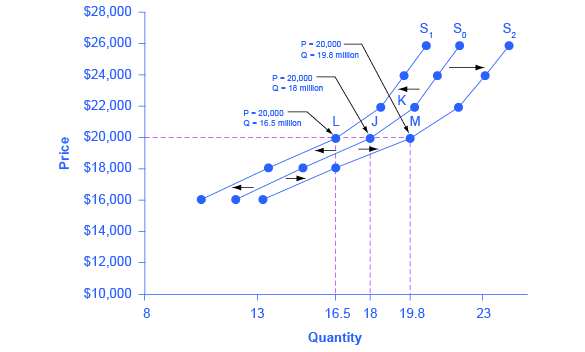
| Price | Decrease to S1 | Original Quantity Supplied South0 | Increase to Due south2 |
|---|---|---|---|
| $sixteen,000 | 10.5 million | 12.0 million | 13.2 million |
| $18,000 | thirteen.five million | 15.0 meg | 16.v million |
| $20,000 | 16.5 million | xviii.0 million | 19.8 million |
| $22,000 | xviii.5 million | 20.0 meg | 22.0 meg |
| $24,000 | nineteen.5 one thousand thousand | 21.0 million | 23.1 one thousand thousand |
| $26,000 | 20.v 1000000 | 22.0 meg | 24.2 million |
| Table 5. Price and Shifts in Supply: A Auto Example | |||
Now, imagine that the price of steel, an important ingredient in manufacturing cars, rises, so that producing a car has go more than expensive. At any given price for selling cars, car manufacturers will react by supplying a lower quantity. This can be shown graphically every bit a leftward shift of supply, from S0 to Sane, which indicates that at whatever given cost, the quantity supplied decreases. In this example, at a price of $twenty,000, the quantity supplied decreases from 18 million on the original supply bend (S0) to 16.5 million on the supply curve Southone, which is labeled as point L.
Conversely, if the price of steel decreases, producing a car becomes less expensive. At any given price for selling cars, car manufacturers can now expect to earn higher profits, and then they will supply a college quantity. The shift of supply to the correct, from S0 to Due south2, means that at all prices, the quantity supplied has increased. In this example, at a price of $20,000, the quantity supplied increases from eighteen million on the original supply curve (S0) to 19.viii million on the supply curve Southii, which is labeled M.
Other Factors That Bear on Supply
In the example to a higher place, we saw that changes in the prices of inputs in the production process volition touch on the price of production and thus the supply. Several other things touch on the cost of production, too, such as changes in weather or other natural conditions, new technologies for production, and some government policies.
The cost of production for many agricultural products will be affected past changes in natural conditions. For example, in 2014 the Manchurian Patently in Northeastern China, which produces nearly of the state's wheat, corn, and soybeans, experienced its almost severe drought in 50 years. A drought decreases the supply of agricultural products, which ways that at any given price, a lower quantity will exist supplied; conversely, peculiarly practiced conditions would shift the supply bend to the right.
When a firm discovers a new engineering science that allows the business firm to produce at a lower cost, the supply bend will shift to the correct, as well. For instance, in the 1960s a major scientific endeavour nicknamed the Greenish Revolution focused on breeding improved seeds for basic crops similar wheat and rice. By the early on 1990s, more than two-thirds of the wheat and rice in depression-income countries effectually the world was grown with these Light-green Revolution seeds—and the harvest was twice every bit loftier per acre. A technological comeback that reduces costs of product volition shift supply to the right, so that a greater quantity will be produced at whatever given toll.
Government policies can affect the cost of production and the supply curve through taxes, regulations, and subsidies. For instance, the U.S. government imposes a tax on alcoholic beverages that collects about $8 billion per year from producers. Taxes are treated as costs by businesses. College costs subtract supply for the reasons discussed above. Other examples of policy that tin can affect price are the wide assortment of government regulations that crave firms to spend money to provide a cleaner environs or a safer workplace; complying with regulations increases costs.
A government subsidy, on the other hand, is the opposite of a tax. A subsidy occurs when the government pays a firm directly or reduces the firm'south taxes if the firm carries out sure deportment. From the firm's perspective, taxes or regulations are an boosted cost of production that shifts supply to the left, leading the firm to produce a lower quantity at every given toll. Authorities subsidies reduce the price of production and increase supply at every given price, shifting supply to the correct. The post-obit Work It Out feature shows how this shift happens.
Shift in Supply
Nosotros know that a supply curve shows the minimum price a house will accept to produce a given quantity of output. What happens to the supply curve when the cost of production goes up? Following is an example of a shift in supply due to a production toll increment.
Step 1. Depict a graph of a supply curve for pizza. Pick a quantity (like Q0). If you draw a vertical line up from Q0 to the supply curve, yous will see the price the house chooses. An instance is shown in Figure 7.
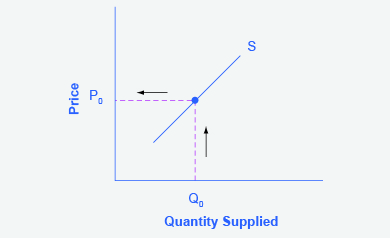
Step ii. Why did the firm choose that cost and non some other? One fashion to think about this is that the cost is composed of two parts. The first role is the boilerplate toll of production, in this case, the price of the pizza ingredients (dough, sauce, cheese, pepperoni, and and so on), the cost of the pizza oven, the rent on the shop, and the wages of the workers. The second part is the firm's desired profit, which is determined, amongst other factors, by the profit margins in that detail business organisation. If you add together these two parts together, you lot get the price the firm wishes to charge. The quantity Q0 and associated price P0 give you one point on the business firm's supply curve, as shown in Effigy 8.

Step three. Now, suppose that the toll of production goes upward. Perhaps cheese has become more expensive by $0.75 per pizza. If that is truthful, the house will want to raise its price by the amount of the increase in cost ($0.75). Draw this point on the supply bend directly above the initial signal on the curve, but $0.75 higher, as shown in Effigy ix.
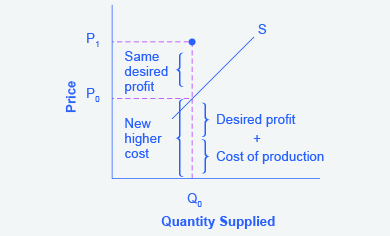
Footstep 4. Shift the supply bend through this betoken. You volition see that an increment in cost causes an upward (or a leftward) shift of the supply curve so that at any toll, the quantities supplied volition be smaller, as shown in Figure 10.
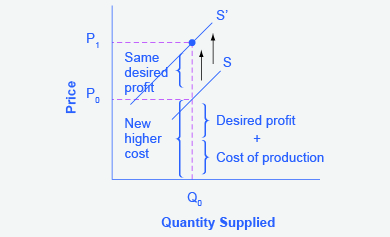
Summing Up Factors That Change Supply
Changes in the cost of inputs, natural disasters, new technologies, and the impact of government decisions all bear upon the cost of product. In turn, these factors touch on how much firms are willing to supply at any given price.
Figure 11 summarizes factors that change the supply of goods and services. Notice that a change in the toll of the product itself is not among the factors that shift the supply bend. Although a change in cost of a good or service typically causes a modify in quantity supplied or a movement along the supply bend for that specific good or service, information technology does non crusade the supply bend itself to shift.

Because need and supply curves announced on a 2-dimensional diagram with only price and quantity on the axes, an unwary company to the state of economics might be fooled into believing that economics is about only four topics: demand, supply, cost, and quantity. However, need and supply are really "umbrella" concepts: demand covers all the factors that touch on demand, and supply covers all the factors that touch supply. Factors other than price that touch on demand and supply are included by using shifts in the demand or the supply curve. In this style, the two-dimensional demand and supply model becomes a powerful tool for analyzing a broad range of economic circumstances.
Primal Concepts and Summary
Economists oftentimes use the ceteris paribus or "other things existence equal" assumption: while examining the economic touch of one result, all other factors remain unchanged for the purpose of the assay. Factors that tin can shift the demand bend for appurtenances and services, causing a different quantity to be demanded at any given toll, include changes in tastes, population, income, prices of substitute or complement goods, and expectations almost future conditions and prices. Factors that can shift the supply curve for goods and services, causing a different quantity to be supplied at any given price, include input prices, natural conditions, changes in technology, and government taxes, regulations, or subsidies.
Self-Check Questions
- Why practice economists utilize the ceteris paribus supposition?
- In an assay of the marketplace for paint, an economist discovers the facts listed below. Land whether each of these changes will bear on supply or demand, and in what direction.
- There have recently been some important price-saving inventions in the applied science for making paint.
- Pigment is lasting longer, so that property owners need not repaint every bit ofttimes.
- Because of severe hailstorms, many people need to repaint now.
- The hailstorms damaged several factories that make paint, forcing them to close down for several months.
- Many changes are affecting the market for oil. Predict how each of the following events volition affect the equilibrium price and quantity in the market place for oil. In each case, state how the event will bear upon the supply and demand diagram. Create a sketch of the diagram if necessary.
- Cars are becoming more fuel efficient, and therefore get more miles to the gallon.
- The winter is exceptionally common cold.
- A major discovery of new oil is fabricated off the declension of Norway.
- The economies of some major oil-using nations, similar Japan, dull down.
- A war in the Middle East disrupts oil-pumping schedules.
- Landlords install additional insulation in buildings.
- The price of solar energy falls dramatically.
- Chemical companies invent a new, popular kind of plastic made from oil.
Review Questions
- When analyzing a market, how do economists deal with the problem that many factors that impact the market are changing at the same time?
- Proper name some factors that tin cause a shift in the demand curve in markets for appurtenances and services.
- Name some factors that can cause a shift in the supply curve in markets for goods and services.
Critical Thinking Questions
- Consider the need for hamburgers. If the toll of a substitute skillful (for example, hot dogs) increases and the price of a complement practiced (for case, hamburger buns) increases, can you tell for sure what volition happen to the demand for hamburgers? Why or why not? Illustrate your reply with a graph.
- How do yous suppose the demographics of an aging population of "Infant Boomers" in the United States volition affect the demand for milk? Justify your reply.
- We know that a change in the cost of a production causes a movement forth the demand bend. Suppose consumers believe that prices volition be rising in the time to come. How volition that affect demand for the product in the nowadays? Tin you lot show this graphically?
- Suppose there is soda tax to curb obesity. What should a reduction in the soda tax practice to the supply of sodas and to the equilibrium price and quantity? Can you bear witness this graphically? Hint: assume that the soda tax is nerveless from the sellers
Problems
- Tabular array six shows information on the demand and supply for bicycles, where the quantities of bicycles are measured in thousands.
Price Qd Qs $120 50 36 $150 forty 40 $180 32 48 $210 28 56 $240 24 seventy Table six. Demand and Supply for Bicycles - What is the quantity demanded and the quantity supplied at a price of $210?
- At what cost is the quantity supplied equal to 48,000?
- Graph the demand and supply curve for bicycles. How can y'all determine the equilibrium toll and quantity from the graph? How can you determine the equilibrium price and quantity from the table? What are the equilibrium price and equilibrium quantity?
- If the price was $120, what would the quantities demanded and supplied be? Would a shortage or surplus exist? If so, how large would the shortage or surplus exist?
- The computer market in recent years has seen many more than computers sell at much lower prices. What shift in demand or supply is nigh likely to explain this outcome? Sketch a demand and supply diagram and explain your reasoning for each.
- A rise in need
- A autumn in demand
- A rise in supply
- A fall in supply
References
Landsburg, Steven Eastward. The Armchair Economist: Economic science and Everyday Life. New York: The Costless Press. 2012. specifically Section Iv: How Markets Work.
National Chicken Quango. 2015. "Per Capita Consumption of Poultry and Livestock, 1965 to Estimated 2015, in Pounds." Accessed April xiii, 2015. http://www.nationalchickencouncil.org/about-the-industry/statistics/per-capita-consumption-of-poultry-and-livestock-1965-to-estimated-2012-in-pounds/.
Wessel, David. "Saudi Arabia Fears $40-a-Barrel Oil, As well." The Wall Street Journal. May 27, 2004, p. 42. http://online.wsj.com/news/articles/SB108561000087822300.
Glossary
- ceteris paribus
- other things being equal
- complements
- goods that are often used together so that consumption of one good tends to enhance consumption of the other
- factors of production
- the combination of labor, materials, and machinery that is used to produce goods and services; besides called inputs
- inferior skillful
- a expert in which the quantity demanded falls as income rises, and in which quantity demanded rises and income falls
- inputs
- the combination of labor, materials, and mechanism that is used to produce appurtenances and services; too called factors of production
- normal good
- a good in which the quantity demanded rises as income rises, and in which quantity demanded falls as income falls
- shift in demand
- when a change in some economic factor (other than price) causes a different quantity to be demanded at every price
- shift in supply
- when a alter in some economic cistron (other than toll) causes a different quantity to be supplied at every price
- substitute
- a good that can supersede another to some extent, then that greater consumption of one good tin mean less of the other
Solutions
Answers to Cocky-Check Questions
- To make information technology easier to analyze complex problems. Ceteris paribus allows you lot to look at the effect of ane factor at a time on what it is you lot are trying to analyze. When you have analyzed all the factors individually, you add the results together to go the final reply.
-
- An improvement in engineering science that reduces the price of production volition cause an increment in supply. Alternatively, yous tin remember of this equally a reduction in toll necessary for firms to supply any quantity. Either way, this can be shown as a rightward (or downward) shift in the supply curve.
- An improvement in production quality is treated as an increase in tastes or preferences, significant consumers demand more than pigment at any price level, so demand increases or shifts to the correct. If this seems counterintuitive, notation that demand in the future for the longer-lasting paint will autumn, since consumers are substantially shifting need from the future to the present.
- An increase in need causes an increase in demand or a rightward shift in the demand curve.
- Factory impairment ways that firms are unable to supply as much in the present. Technically, this is an increase in the cost of production. Either way you look at it, the supply curve shifts to the left.
-
- More fuel-efficient cars means there is less need for gasoline. This causes a leftward shift in the demand for gasoline and thus oil. Since the demand curve is shifting down the supply curve, the equilibrium toll and quantity both fall.
- Cold weather increases the need for heating oil. This causes a rightward shift in the need for heating oil and thus oil. Since the demand curve is shifting up the supply curve, the equilibrium toll and quantity both rise.
- A discovery of new oil will make oil more than abundant. This tin exist shown as a rightward shift in the supply curve, which volition cause a subtract in the equilibrium cost along with an increase in the equilibrium quantity. (The supply curve shifts downward the demand curve so price and quantity follow the law of demand. If price goes downward, so the quantity goes up.)
- When an economy slows downwards, information technology produces less output and demands less input, including energy, which is used in the production of virtually everything. A decrease in demand for energy will be reflected as a subtract in the need for oil, or a leftward shift in demand for oil. Since the demand curve is shifting downwardly the supply curve, both the equilibrium price and quantity of oil will autumn.
- Disruption of oil pumping will reduce the supply of oil. This leftward shift in the supply curve will show a movement up the demand curve, resulting in an increase in the equilibrium toll of oil and a decrease in the equilibrium quantity.
- Increased insulation volition decrease the demand for heating. This leftward shift in the demand for oil causes a motion down the supply curve, resulting in a subtract in the equilibrium price and quantity of oil.
- Solar energy is a substitute for oil-based energy. And then if solar energy becomes cheaper, the need for oil will subtract as consumers switch from oil to solar. The decrease in demand for oil volition be shown every bit a leftward shift in the need curve. Equally the need curve shifts downwardly the supply curve, both equilibrium price and quantity for oil volition fall.
- A new, popular kind of plastic volition increase the need for oil. The increase in demand will exist shown as a rightward shift in demand, raising the equilibrium cost and quantity of oil.
Source: https://opentextbc.ca/principlesofeconomics/chapter/3-2-shifts-in-demand-and-supply-for-goods-and-services/
0 Response to "Name Some Factors That Can Cause a Shift in the Supply Curve in Markets for Goods and Services."
Post a Comment